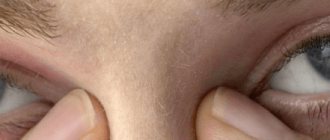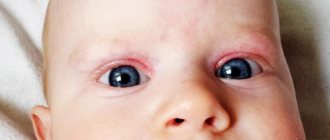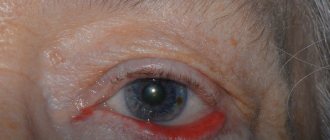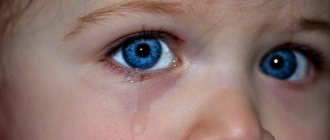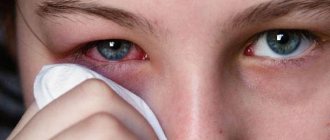From time to time, every person experiences itching of the eyelids. He begins to scratch them, causing even more damage to his eyes.
This often happens in the morning, when a person has not had time to adapt to bright light.
Short-term episodes of itching are not a reason to go to the hospital. However, many diseases occur hidden. Therefore, a visit to the ophthalmologist is mandatory if such a symptom bothers you daily or every night.
There are many reasons for this symptom - from fatigue to serious illnesses. An interesting fact is that the cause can be determined by the place where the itching first appeared.
Causes
Age-related changes
As people age, the amount of natural tear fluid decreases, this is due to dysfunction of the lacrimal glands. The quality of the tear decreases, as does its fat content.
Tears evaporate from the eye faster, and new ones do not have time to wash it. When the eyelids close and open, friction occurs, resulting in itching and burning.
After eyelash extensions
Eyelash extensions are a modern alternative to everyday makeup. Sometimes girls have an allergic reaction. There are several reasons:
- sensitive skin;
- violation of extension technology;
- use of cheap materials.
The eye begins to itch and peel. Symptoms increase gradually, including coughing, inflammation of the nasal mucosa, continuous sneezing, lacrimation, and irritation of the nasal mucosa. Swelling of the upper eyelid appears.
Foreign body
Small particles irritate the mucous membranes of the eyes. Redness appears, the victim rubs the eye vigorously, which intensifies the itching.
You can remove the foreign body yourself; if this does not work, seek qualified medical help.
Stress
Stress, depression and ordinary overexertion, which appears day after day, are manifested by itching and thinning of the eyelash rows. It is recommended to limit yourself from stressful situations and, if necessary, visit a psychologist.
Dry eye syndrome
Dry eye syndrome is characterized by drying out of the mucous membrane and cornea of the eyeball. The pathology develops due to disruption of the functioning of the meibomian glands when exposed to unfavorable factors such as wind, dust, or air conditioning in the room.
Main symptoms:
- redness;
- feeling of dryness;
- feeling of sand in the eyes;
- discomfort;
- pain;
- burning.
Allergic reaction
The number of allergens increases every year. The allergy begins with sneezing, watery eyes, and nasal mucus. Both eyes are very itchy and red.
The cause of such a reaction can be wool, decorative cosmetics, household chemicals, and pollen.
Avitaminosis
Avitaminosis is a lack of vitamins. As a rule, the body lacks a group of beneficial vitamins. It manifests itself as peeling skin, peeling nails, and hair loss.
From the visual organs and eyelids - redness, lacrimation, itching and swelling.
Conjunctivitis
This disease refers to inflammation of the connective tissue membrane that covers the inside of the eyelids and spreads to the sclera and cornea. Most often, conjunctivitis develops due to pathogenic bacteria, viruses, mechanical and thermal irritants.
Barley
Ripening hordeolum causes severe itching in the eyes. Purulent inflammation of the hair follicle of the eyelash or meibomian gland is manifested by swelling, redness of the skin and conjunctiva.
Subsequently, an abscess forms, the opening of which leads to the release of pus and particles of dead tissue.
Stye is an infectious disease that most often develops due to rubbing the eyes with dirty hands.
Trachoma
An infectious chronic disease of the conjunctiva and cornea also affects the eyelids. If treatment is not started in a timely manner, the edges of the eyelids become deformed and vision decreases sharply.
Trachoma is transmitted by contact and is most often observed between the ages of 3 and 6 years.
Squamous blepharitis
The disease is characterized by thickening of the edges of the eyelids and redness. Small scales begin to form at the base of the eyelashes. There is a burning sensation in the eyelids, and in some patients the eyelashes turn gray and fall out.
Demodectic blepharitis
A parasitic disease caused by Demodex mites. Signs of the disease resemble the usual course of blepharitis with inflammation, redness, peeling, itching and pain when touching the eyelids.
The demodectic form of the disease differs from others in the appearance of acne on the face.
Herpes virus
A herpetic infection can lie dormant for a long time and not manifest itself. Triggering factors such as pregnancy, hypothermia, stress or injury trigger the development of the disease.
Herpetic infection mainly affects the area of the upper eyelid and eyebrows. When the second branch of the trigeminal nerve is affected, the disease spreads to the lower eyelid, which becomes red and itchy.
Sjögren's syndrome
The disease is dangerous and common among women over 40 years old. Pathology can significantly reduce the quality of life, so treatment should begin immediately.
Sjogren's syndrome in half of the cases is accompanied by regular exacerbations. Other signs of pathology:
- hoarseness of voice;
- hearing impairment;
- excessive dryness of mucous membranes and skin;
- Women experience vaginal dryness.
Diabetic retinopathy
The disease refers to damage to the retina, which is caused by uncontrolled diabetes. Diabetic retinopathy is characterized by microvascular damage, the formation of connective tissue scars and retinal detachment.
Corneal ulcer
Ulcerative keratitis is a serious disease that can lead to complete loss of visual perception. Symptoms:
- sensitivity to light;
- strong pain;
- anterior uveitis;
- pupil reduction;
- Tyndall effect.
Glaucoma
This condition includes a group of eye diseases that are characterized by a constant increase in intraocular pressure. There are open-angle and closed-angle types.
Glaucoma causes vision loss. Peripheral vision deteriorates first, then central vision.
Why is the skin around the eye dry, what to do
Dry skin around the eyes can be caused by various reasons. Sometimes they are completely harmless: unfavorable weather conditions, incorrectly selected cosmetics, lack of water in the body, etc. But in some cases, dryness can be a sign of a dermatological disease: eczema, psoriasis, seborrheic dermatitis and others. Peeling and itching bring significant discomfort. The problem can be solved by using moisturizing masks and compresses made from folk remedies. But if dryness is caused by an illness, you cannot do without treatment from a professional doctor.
Dry skin around the eyes is determined by the following signs:
- first, the skin in this area begins to dry and peel;
- then itching appears, the eyelids constantly itch;
- if you rub your eye, the skin around it turns red;
- at the last stage, the redness becomes covered with a crust, which can hurt and eventually begins to crack.
All this does not decorate the face and causes serious discomfort. In addition, dry epidermis leads to accelerated formation of wrinkles.
If you do not pay attention to these symptoms in time and do not begin treatment, there is a risk of a secondary infection associated with damage to the skin.
Dry skin around the eyes can be caused by many reasons. These include:
- weather conditions (strong wind, low humidity, etc.);
- dry air in the house;
- use of cosmetics that are not suitable for your skin type;
- prolonged exposure to the sun;
- taking a shower or bath with hot water;
- lack of water or vitamins in the body;
- friction of delicate skin and other mechanical damage;
- dermatological diseases (eczema, psoriasis, seborrheic dermatitis);
- blepharitis;
- disruptions in the hormonal system, in which the sebaceous glands of the eyelids do not work correctly;
- bacterial infections (for example, lichen);
- allergic reactions;
- ocular conjunctivitis and other mucosal irritations.
These diseases sometimes occur due to stress. Therefore, overwork, lack of sleep and depression are also considered indirect causes of dry skin.
Women face this problem more often than men. After all, women's skin is much more prone to dryness.
In children, the skin around the eyes is especially thin and delicate. Therefore, irritation easily occurs under the influence of negative environmental factors. In addition, the child often develops various allergic reactions.
If the skin of your eyelids is crusty and itchy, you should not self-medicate. Before using any products, you should consult a dermatologist.
If dryness is caused by weather conditions, incorrectly selected cosmetics and other harmless reasons, you can get rid of the problem at home. Treatment methods:
- the use of moisturizing creams and oils;
- the use of masks and compresses from folk remedies.
You also need to drink enough water. If the air in your home is too dry, you will need to install a special humidifier.
Proper eyelid skin care must include high-quality moisturizing. This is especially important in winter, when the epidermis dries and cracks.
When purchasing a cream, you should pay attention to the composition. It should include as many natural ingredients as possible that will not further irritate the skin.
You can also use aloe juice at home. It has anti-inflammatory and wound healing effects. In addition, this product perfectly moisturizes the skin. Both a freshly cut plant and a ready-made pharmaceutical gel will do. They lubricate the skin around the eyes and eyelids twice a day. But this must be done carefully so that the aloe juice does not get on the mucous membrane.
You can also use natural cosmetic oils sold in pharmacies. It can be jojoba, avocado, wheat germ, peach, coconut or almond oil. A few drops are carefully applied to the area around the eyes and rubbed in to allow the oil to be absorbed.
Another available moisturizer is Vaseline. It helps retain moisture, remove flaking and restore irritated skin.
It is also easy to prepare compresses at home using available products. They act quite quickly, relieving irritation and itching. It is recommended to use masks in the morning and evening until the dry skin goes away.
One of the easiest ways is to use cucumbers. You will need:
- grate the pulp of a fresh cucumber;
- wrap the resulting mass in gauze and apply to problem areas;
- leave for 10–15 minutes;
- then apply moisturizer.
You can simply cut the cucumbers into rings and put them on your eyes.
A cucumber compress can soothe and moisturize dry eyelid skin.
You can also use regular tea bags.
- take 2 tea bags and moisten with cold water;
- then put them on your eyelids;
- wait 10–15 minutes.
Tea contains antioxidants. Due to this, it promotes cell regeneration and prevents the appearance of wrinkles.
Cold milk will help restore and soothe inflamed skin. To do this you need:
- moisten 2 cotton pads with cold milk;
- apply them to your eyes for 15–20 minutes.
It is advisable to use unpasteurized (raw) milk.
Honey also has beneficial properties. To prepare a mask with this component, you will need:
- take natural vegetable oil (linseed, coconut, peach, almond, jojoba, avocado, etc.);
- Mix 1 tablespoon of honey with the same amount of selected oil;
- if the composition is too thick, you can add a little more oil to bring the mixture to the desired consistency;
- Gently apply the mixture to the skin of the eyelids and under the eyes.
Keep the mask on for 20 minutes, then rinse with warm water.
Another mask recipe for treating dry skin around the eyes contains peach puree and cream. To prepare such a compress you need:
- take a few peaches and rinse them;
- peel them and remove the seeds;
- put peeled peaches in a blender and grind them into puree;
- take the amount of peach puree required to prepare the mask and add a little cream;
- wrap the resulting mass in gauze and apply to the inflamed areas for 20 minutes;
- After this time, rinse your eyes and apply a moisturizing or nourishing cream.
Treatment
Medicines
The choice of drugs depends on the cause of the disease. Medicines are prescribed by an ophthalmologist after a thorough examination of the patient.
Table. Treatment methods depending on the cause
| Disease | Medicines |
| Glaucoma | Medicines are prescribed that moisturize the eyeball and lower IOP, mainly eye drops. For example, Sodium nitrite, Alphagan, Xalatan. |
| Corneal ulcer | It is treated exclusively in a hospital setting. Antifungal, antibacterial, mydriatic, immunomodulatory and antihistamine medications are prescribed. |
| Dry eye syndrome | The patient is prescribed moisturizing drops. Visine and Artificial tears cope well with the problem. |
| Allergic reaction | Antihistamines and corticosteroids - Hydrocortisone, Dex-gentamicin, Vial, Opatanol, Ketotifen, Acular. |
| Conjunctivitis | Diklo-F, Vitrum Vision, Zovirax, Poludan, Garazon, Maxitrol, Dexamethasone and other drugs from the group of hormonal, anti-inflammatory, moisturizing and antibacterial drops. |
| Barley | Levomycetin, Tobrex, Oftalmodek, Ciprofloxacin. |
| Trachoma | Taking vitamin-mineral complexes, interferon preparations and immunomodulators. |
| Squamous and demodectic blepharitis | Normax, Hydrocortisone ointment, Visin, Natural tear. For demodectic blepharitis, the edges of the eyelids are treated with alcohol solutions, |
| Herpes virus | Prescribe antiviral drops, oral use of antiviral drugs, interferon preparations. |
| Sjögren's syndrome | Prescribe moisturizing drops, Cyclosporine, Pilocarpine, Cevimelin hydrochloride. |
| Graves' disease | The patient takes glucocorticoids, sedatives, beta-blockers and potassium preparations. |
| Diabetic retinopathy | Troxevasin, Vitrum Vision forte, Inosine, Dihydroergocriptine, vitamins. |
Traditional methods
The methods offered by traditional healers are used in combination with drugs. Home remedies do not always help cure the disease; more often they only relieve unpleasant symptoms.
Use home treatment only after consultation with an ophthalmologist; any independent actions may lead to an undesirable result. Popular among folk remedies are:
- tincture of lily of the valley;
- tea compresses;
- propolis drops;
- honey-milk compress;
- infusion of chamomile and calendula;
- raw potatoes;
- cottage cheese paste.
Natural remedies for peeling eyelids
If peeling of the eyelids is caused by dry skin, exposure to cold, wind, eye fatigue, lack of vitamins and nutrients, then a balanced diet, taking supplements, thoroughly moisturizing and nourishing the skin around the eyes will help solve the problem. At first, the main thing is to soften the skin; it is useful to make masks with olive oil, preferably at night. It is also recommended to use almond oil, it nourishes well and relieves irritation.
Oatmeal steamed in hot milk has a good softening effect. Before applying it to your eyelids, you need to cool it a little and add butter. Try making applications from mashed banana and carrots; boiled potatoes also work well. A remedy made from bread soaked in milk, which should be applied to the eyelids daily, has also proven itself. If peeling of the eyelids is caused by demodicosis, you cannot make masks with oils; first of all, disinfection of the affected skin is necessary.
The following home remedies effectively fight eyelash mites:
- washing with tar soap and lubricating the eyelids with sulfur ointment or birch tar;
- compresses from a decoction of buckthorn, linden or juniper;
- washing with a decoction of oak bark and compresses with fresh cabbage juice;
- alternate use of cold and hot compress with chamomile decoction.
No matter how varied the folk recipes are that help eliminate peeling skin on the eyelids, remember that a visit to an ophthalmologist and dermatologist should come first.
Source
Prevention
The main prevention of any ophthalmological disease is a timely visit to the ophthalmologist and compliance with hygiene rules. Do not touch your eyes with dirty hands or do not wash off your makeup before going to bed. Recommended:
- do exercises every 60 minutes with prolonged visual stress;
- observe a rest and sleep schedule;
- consult a doctor rather than treat the disease yourself;
- Do not allow others to use eye makeup or towels.
It is impossible to live normally with constant burning and itching. In the absence of timely measures to treat the disease, they lead to complications, the most difficult of which is complete loss of vision in the affected eye.




